Animation Artifacts 16 Feb 2007 07:49 am
Jiminy Crickets
Anyone know of any scenes animated recently that could compare with this one? Talk about loving the old days; my true colors are showing. This is a Milt Kahl scene Seq. 3 Sc. 26. (Thanks to Mark Mayerson and Hans Perk for this information.)
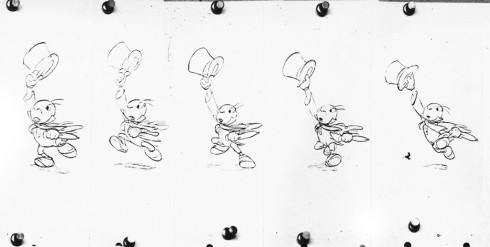
Notice how long that hat stays up there before he plops it on his head.
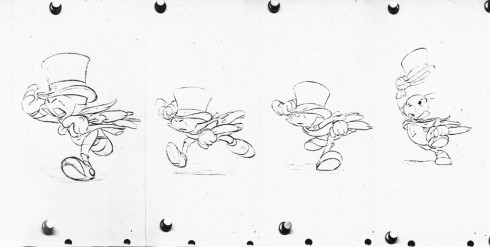
His head scrunches way down when the hat finally hits. The animation doesn’t pop in place as today’s animators would do (thinking they’re giving homage to Tex Avery, or maybe that’s all they know.)
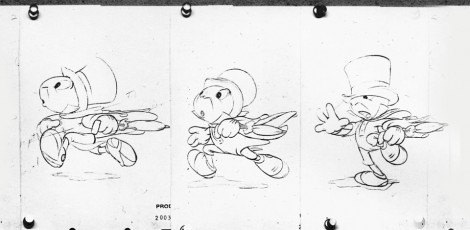
Something tells me the MoCap version of this scene wouldn’t work quite like this. I’m not completely convinced that even a cgi version would have such personality.
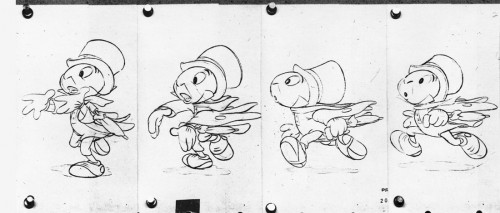
Notice how Jiminy’s hands come forward, calling attention to them in all the broad movement. This anticipates his next action which isn’t very large.
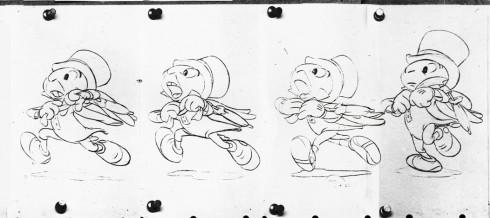
He fixes the tie. Loses it . . .
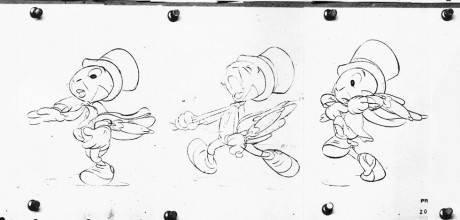
. . . and fixes it again. Good work.
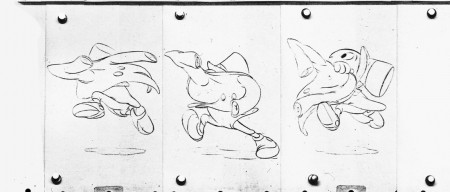
He uses the jump to fully get his coat on. Weight and gravity work for him here.
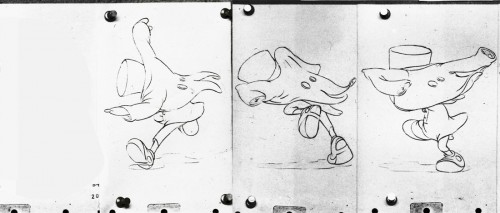
I love how he tries to push the umbrella throrugh the sleeve . . .
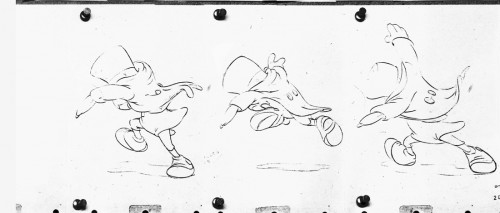
. . . and eventually pops it through.
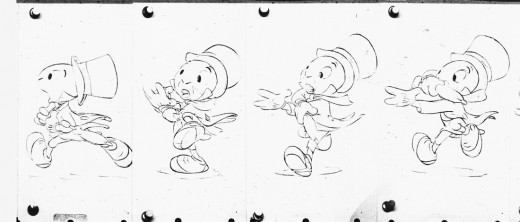
Finally, he puts the umbrella on his arm so as not to deal with it anymore.
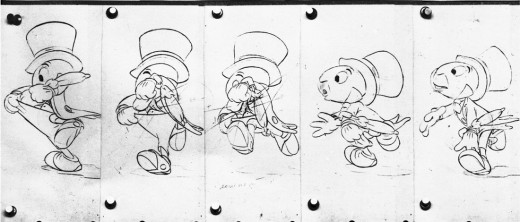
Almost a full stop to tuck in his pants.
This is a great scene; it uses an economy of drawing while developing character and still moving the film foreword. It goes beyond the drawings as all good animation does.
(Some of these drawings appeared as a flip book in the Thomas/Johnson book The Illusion of Life.)
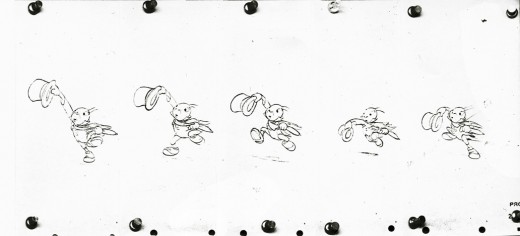
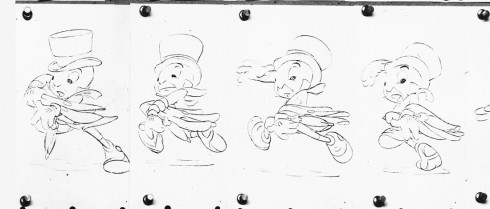
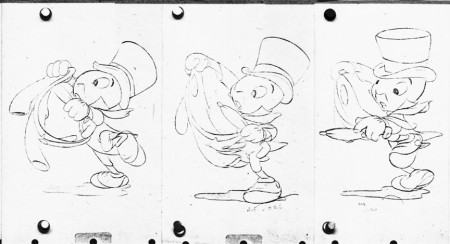
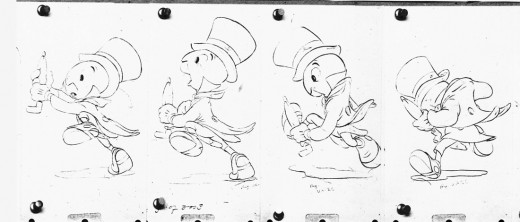
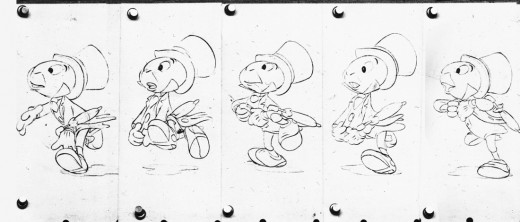
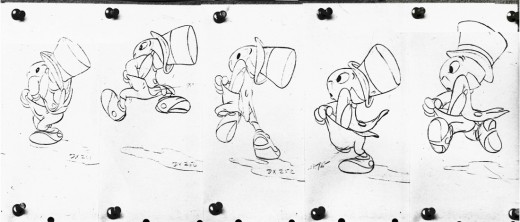
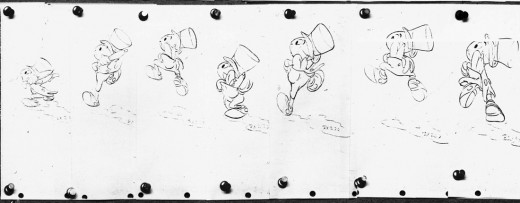

on 16 Feb 2007 at 8:12 am 1.Mark Mayerson said …
You should mention that the animation is by Milt Kahl. It really is a tour de force. Dealing with all those elements like the coat and umbrella while always having a strong silhouette and line of action and still making sure that the character’s emotional state comes through. Whew!
The cloth in this scene would make it a nightmare for cgi. Even if the animator was skilled enough to do the character, a technical director would have to do some very heavy lifting to get the coat and the shirt to work believably.
on 16 Feb 2007 at 8:26 am 2.Brian Sibley said …
This is a WONDERFUL sequence of drawings from my favourite Disney film! They are so full of warmth, vigour and energy… Brilliant, brilliant, brilliant!
I am very pleased to have discovered SPLOG (courtesy of The Disney Blog and the late Peter Ellenshaw) and qwill be coming rtound on regular visits – as well as adding you to my animation links…
on 16 Feb 2007 at 8:53 am 3.Hans Perk said …
A great scene, Seq. 3 Sc. 26 – the draft info for this scene you can find here. Thanks for posting it, Mike!
on 16 Feb 2007 at 11:39 am 4.David Nethery said …
What a great way to start my day, viewing these wonderful drawings.
I have never ceased to be blown away by the virtuoso animation in this scene every time I’ve watched it. I’m amazed how it’s not only a great ACTION scene , but also the ACTING and lip sync comes through so clearly . I’ve stepped through this scene frame-by-frame many times, but I’ve never had all the drawings pasted up like this to linger over. Thanks !
on 16 Feb 2007 at 2:46 pm 5.Keith Lango said …
W o w.
You’re not gonna be doing this in CG for a long, long, long time. As Mark noted the cloth alone would require a team of technicians. Never mind the ability to build the rig with enough give and take to handle the shape shifting. Plus there just aren’t enough CG animators good enough to do this right now. (yours truly included)
Yet a question arises: Why does CG have to do be able to this scene to be valid? I mean why not say “I am not completely convinced that a stop-motion version of this scene would have such personality.”? I guess I’m wondering why CG has to emulate hand drawn to be considered all grow’d up. This isn’t to say that CG isn’t in serious need of a swift kick in the creative pants- it is and I usually have my boots on. Even so, when does CG cross the threshold of being good for what it is? When does it stand on its own with it’s own unique strength and style that can be appreciated? Again, I don’t believe it has arrived there yet- not by a long shot. I just wonder if anyone has thought about where/when that point arrives.
Thanks for sharing the drawings. I’m tempted to plop them into a Quicktime, but without the timing charts I’m hesitant to try for fear of making a hash of it.
on 16 Feb 2007 at 3:20 pm 6.Michael said …
I probably shouldn’t have picked on cgi, it just came out – an automatic and unfair response after knocking MoCap. The fact is, I’m not sure there are many 2D animators today who could do this quality.
on 16 Feb 2007 at 4:27 pm 7.Keith Lango said …
Oh, no worries. I hope the question didn’t come off like I was offended for CG’s honor or anything- far from it. The question is just something that’s been rolling around in my head for a few years. I’m pretty sure it hasen’t been answered yet, which probably makes asking it kinda unfair. Heh.
But you hit on another point- what animators are available in the world today who can do this level of quality in any medium (allowing for that medium’s relative stengths, etc.)? Ten? Five? This piece kicks my butt, that’s for sure.
on 16 Feb 2007 at 8:02 pm 8.Hans Perk said …
Why not pick on cg? The thing is, as Keith asks: “when does CG cross the threshold of being good for what it is?” and the answer is: “when CG personalities are believable in the story they are set in.” Yes, this means that even very stiff characters CAN be “good for what they are.” But that is no reason to forget what COULD be done by a master animator, in this case drawing by hand. In some of the best CG, we do get the feeling the characters are thinking, breathing, living beings.
But too often, they are just computer-generated dead puppets, like in the current French ‘Arthur and the whatsits’ feature. MoCap tends to just add to the puppet feeling, like in Polar Express or Happy Feet. Why not reach for the best that can be done? Why settle for “good enough?” And that is, what I see too often in CG nowadays: the thought that “it’s in CG and it moves, so it’s good enough. Shrek, Ice Age and Toy Story moved, are CG and made a lot of money, so that must be the criterium.”
CG animators really SHOULD undergo the same amount of study as the Disney animators under Don Graham in the 30s: action analysis, acting lessons etc., and this is why often the 2D animators that made the change to CG fair so much better: they have that advantage over the many kids who started in CG by downloading the software while in school. Be they CG or 2D animators, there should be no excuse for not trying harder…
Hearing Brad Bird in the Spline Doctors podcast is a great reitteration of what I’ve been talking about for many years, including on 2D: animators, mostly the young ones, use too many “standard animation”, and study other animators instead of studying life. Much of the CG I see recently suffers from this: I see scenes from Toy Story replayed in Flushed Away or Meet the Robinsons, instead of new, heart-felt, individual animation. In a case like that, I’d rather see Toy Story again… So please, let’s not settle for “good enough!”
on 17 Feb 2007 at 12:02 am 9.Pete Emslie said …
One area that I think traditional drawn animation has an edge over cg is in doing visual “cheats”. Pinocchio’s legs rotating completely around at the knee-joints when he dances, or the giant hammer that Mickey pulls out of his overalls in “The Little Whirlwind” which then quickly disappears back into his pants once he’s nailed the leaf basket in place. Optical illusions like these require tremendous visual sleight-of-hand, as well as benefit from the absence of surface detail, light, shadow and texture that seem to be prerequisites of cg.
The clarity of the “2D” drawn image also seems to benefit and visually clarify rapid-fire bits of business like this animation of Jiminy dressing while in mid-run, which probably too includes some visual cheats. Again, I think that all of the fully rendered cg approach would leave this stuff lost in a muddled mess, not reading clearly and quickly to the viewer as it should.
Both drawn animation and cg animation have their respective strengths and weaknesses, in my opinion. I’ve always felt that drawn animation was better at portraying more intimate stories, involving smaller casts and featuring set pieces that have more in common with stage production than with Cinemascopic movies. Intimate stories like “Dumbo” and the dog’s eye view perspective of “Lady and the Tramp” excel in drawn animation. I think that whimsical and abstract imagery like much of what exists in “Alice in Wonderland” and “The Three Caballeros” are also shown to much greater effect with drawn animation and its ability to successfully fool the eye.
In contrast, I believe that cg animation is better able to handle stories of epic proportion, involving backgrounds of huge animated crowds or scenes of great physical depth such as the ocean vistas of “Finding Nemo”. For example, the scene in “Finding Nemo” where the whale gradually emerges out of the murky underwater background could not possibly be done as effectively in traditional animation, as it really seems to demand the same properties one would find in live-action filmmaking of dim lighting and a feeling of actually being immersed in real water. Had such a scene been required in a traditional film like “The Little Mermaid”, it would likely have been staged much differently to be credible, perhaps having the whale slowly emerge upwards into the scene from below rather than from the background as it does in “Nemo”.
Anyway, I believe both types of animation serve their purpose, depending on the type of storytelling desired, so I agree with Keith that we should not demand exactly the same results from the other. Both are valid techniques that have their own strengths and weaknesses.
on 17 Feb 2007 at 12:52 am 10.Floyd Norman said …
Wow! Brilliant work!
As one who was lucky enough to assist Milt Kahl back in the sixties, he never fails to amaze me. I truly wanted to be an Disney animator, yet somehow ended up in story instead.
In any case, thanks so much for posting this work. Milt was awesome. I know. I had to look at his stuff every day.
on 17 Feb 2007 at 4:34 am 11.Mac Cauley said …
Wow! What a great scene. Thanks for posting these beautiful drawings. If only all animators today could aspire to such great animation as Kahl is doing here. It certainly inspires me and I also have to pick up this incredible film on dvd.
on 17 Feb 2007 at 3:40 pm 12.Keith Lango said …
It’s a sad truth (but one vehemently denied within the halls of CG film studios, BTW) that a large portion of currently working CG film animators are very inexperienced. It’s a young man’s game with young man’s economics. If one remains at the same studio for 5 years it is almost guaranteed that they will become a lead or a senior animator, if not a full blown supervisor. Contrast this to the old days of Disney where one might be able to move from being an assistant to a full animator in the same period of time. The acceleration of CG animators into a position of creative responsibility is frightening. Kids right out of school or with well less than 2 years of professional experience are hired and given performance scenes in every film you see on screen. And we’re not talking about a few here or there, either. The number of CG animators currently working with more than 10 years animation experience is rather slim. Perhaps less than 25% of the whole. A typical film crew of 35 or 40 animators breaks out to about 20-30% old pros (7+ years) 30-40% journeymen (3-7 years) and 30-40% young guns (less than 3 years experience). Outside of a few rare experiments there has been no such thing as an assistant animator in CG. The effect on the quality of the performances comes as no surprise in light of this.
The 2d animators who were able to grok with the machine certainly help raise the bar, but sadly many failed to make the transition owing to the difficulty of dealing with the computer. And as a former supervisor I can’t tell you how many demo reels came across my desk from formerly traditional animators who had wonderful hand drawn work but their CG work looked as if they had forgotten every single good thing they ever knew about animation. I don’t know why but there must be something about working on the computer that makes it easy to accept pretty sub-par work. I was once guilty of it as well. I think having everything on ones and so preternaturally smooth is like an intoxicating drink or something.
Nowadays there is a growing number of film animators who basically rotoscope themselves acting out their scenes on a digital camera- all done under the guise of calling it “video reference”. One would think that this would be seen as a rather poor trend by the Cg film animator culture, but quite the opposite seems to be true. This technique is being taught as *the* best way to achieve highly believable acting/motion in some rather famous animation schools and programs. The use of this technique within the halls of the most respected of CG animation studios only seems to be adding legitimacy to this practice. If this is how CG animation is going to “improve” itself then I hold low hopes for it as a medium. And I am (and always have been) a CG animator.
on 17 Feb 2007 at 11:27 pm 13.Mark Mayerson said …
I want to say two things in defense of cg animators. The first is that a pencil animator must rely on his or her own draftsmanship, but a cg animator is at the mercy of the rigger. The kind of things that a pencil animator can take for granted, assuming drawing skill, can be tough for a cg animator especially if the character isn’t rigged properly. Line of action, stretch and squash, all kinds of localized distortion are things that may not be built into characters, leaving animators to struggle to create the performances they see in their heads.
The second issue is the quality of management. (That is no dig at you, Hans!) The animation business has been invaded by producers who are completely ignorant of what animation is. These people have no clue how to create a story and often put the wrong person in the director’s chair. I am not talking about the larger cgi studios (though I often don’t like their films) but the second tier that’s attempting to break into the market is suffering from a lot more than weak or inexperienced animators.
You need more than good animators to create something worth looking at. Glen Keane animated on The Chipmunk Adventure and nobody holds that film up as an example worth emulating. The same things that hurt that film are now hurting many of the cg features.
All animators need to be better than they are, regardless of their medium. But no animators can be held responsible for all the sins of the films they work on.
on 19 Feb 2007 at 11:55 am 14.Simon Ward-Horner said …
Thanks for posting this. It is wonderful to see this example of virtuoso animation…a truly masterful sc.
I agree with the comment above regarding the cliches in animation and the need to dig deeper and do ones research in movement and acting; to create true performances in animation and not just rehashes of tired old, worked once so it’ll work again stuff we do tend to see popping up now and again.
You can be sure that Milt thumbnailed this sc out until he was certain what he wanted to do with it. That, coupled with his marvellous drawing skills created this treasure. I reckon anyone who intends to excel at their craft has to look carefully at how these acknowledged masters achieved their results, not copy their results.
I heard a story, I think it was about Michelangelo, on looking at what the mannerists were doing, after having been so impressed with Michelangelo’s style he said, ‘I have created a generation of idiots.’
Something to be avoided, I think.
on 16 Dec 2007 at 5:55 am 15.bruce said …
C’mon it wasn’t long after this “picture” Disney’s pinochio(?) came out that, at least in my early lifetime, the art in hand made cartoons became more simpler, less quality, rotoscoped etc. etc. Way before CG came on the scene. I always liked the stop action alternatives. But no one today, wants to pay that man who could draw as that one Milt kahn, or any other disney “master” is or would be worth. Think of how much $money$ eisner could save if he only needed a small bldg. full of artists like walt had back then. Why he could make kazillions and only pay them “peanuts”. The question; are there any artists like those guys today? where are they, and how com they aren’t working on projects like that, together?
on 16 Dec 2007 at 9:35 am 16.Michael said …
Because people like you with the limited knowledge of history think everything can be ratcheted down to money. Beowulf cost $150 million. It could have been more effective as a live action film with effects for that price. Artists are ready and willing and able to work. The system tries to low ball everything into a corner, and the system dies.
on 30 Jun 2008 at 9:50 am 17.Stephen Perry said …
Give a thought for the assistant who had to retain Milt’s roughs but give a cleaned-up version on model. Sometimes scenes like this were animated on long lengths of paper, starting on one side and animating the character across to the other side. Which made it easier too pan both bg and cels at the same time together, try doing that today and it just confuses scene planners after the drawings have been scanned into the computer. I had the great opportunity to work with Milt’s last assistant, Stan Green who was stuck in the corner of the studio and under used, because they thought he was old fashioned. Just one other thought about the Jiminy scene they would have had anything they wanted filmed in live action as a reference to aid the animators, a great starting point which is often left to the animator to film himself. At Disney’s they would have had professional actors come in and be filmed doing the scene…
on 30 Jun 2008 at 10:52 am 18.Michael said …
This, certainly, is all true. However, they wouldn’t have used the rotoscoped scene as faithfully as they would today. Certainly, the Don Bluth late films such as Anasatasia, Thumbelina or Titan A.E. were TOO dependent on that live action. Perhaps that was done rather than take the time to properly train new animators and push films out on a rushed schedule?
on 18 Aug 2008 at 4:21 pm 19.AlexM said …
Your blog is interesting!
Keep up the good work!
on 06 Mar 2010 at 5:43 am 20.Steven Hartley said …
Wow! I’m suprised that Milt Kahl could actually animate this, Milt Kahl was one of the expert animators, also great at animating “hands”. I mean, this is an achievement in the Golden Age of Animation. Pinocchio, one of the best Disney films, great animation, great story!